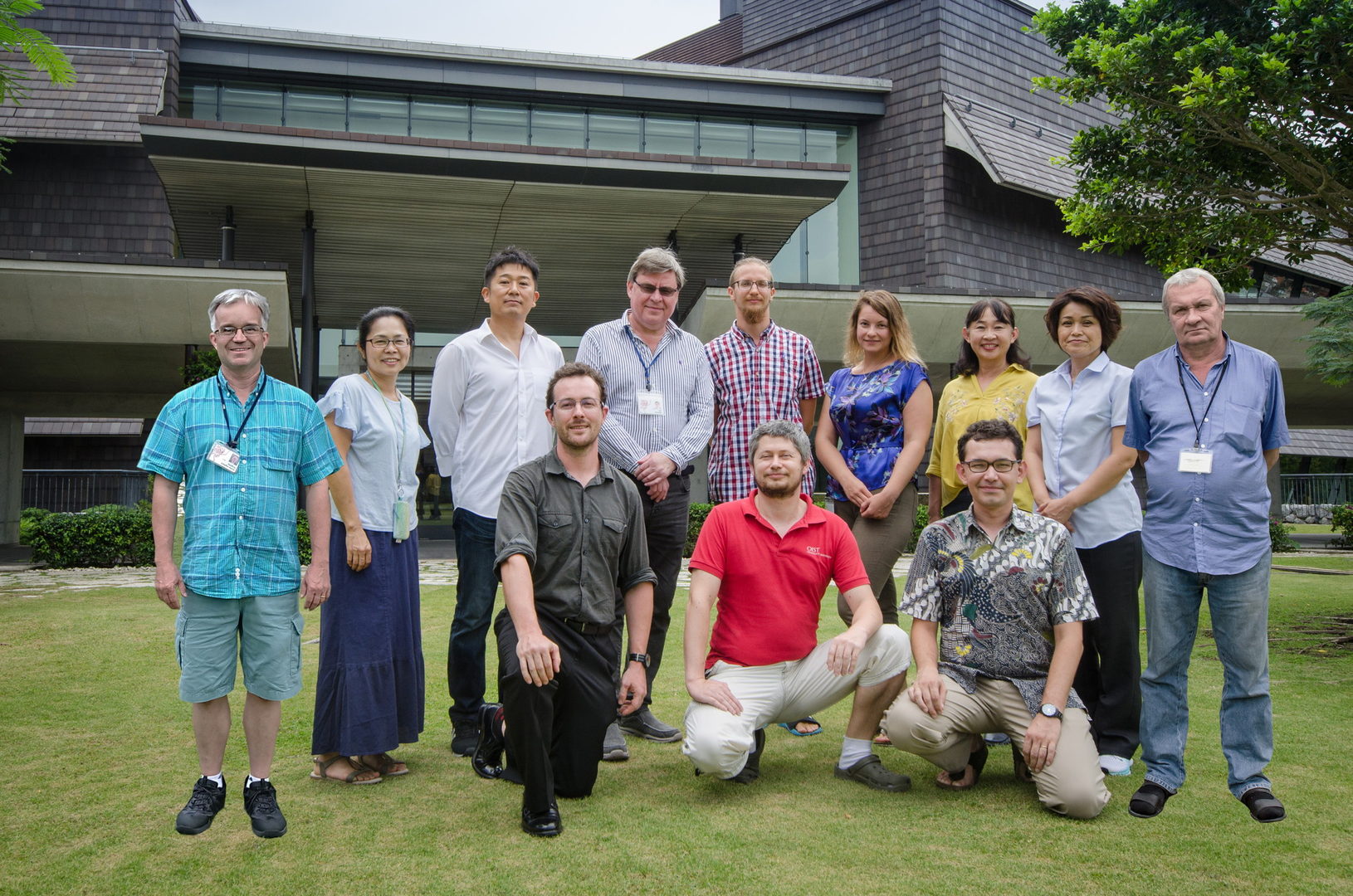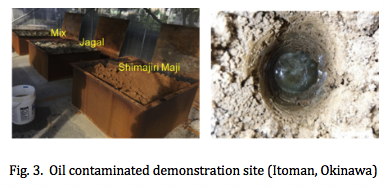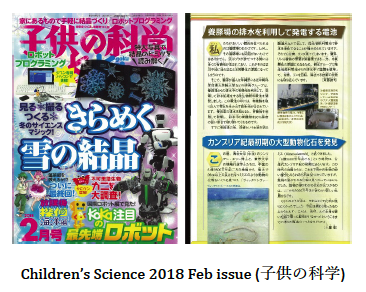FY2017 Annual Report
Biological Systems Unit
Professor Igor Goryanin

Abstract
For last years, the Biological Systems Unit has been engaged in development of BioElectrochemical System (BES)/Microbial Fuel Cell (MFC) technology for wastewater treatment. The BES/MFC applies complex interactions between microbial populations and electrodes to remove organics and to generate electricity, merging basic and applied goals of our Unit. By utilizing biological, chemical, engineering, and bioinformatics approaches, the Unit seeks to improve BES/MFC systems for better treatment efficiencies and electricity generation by understanding and building ideal microbial communities and developing cost-effective materials. Sustainable wastewater treatment is especially important for small islands like Okinawa.
One of the challenges of this technology is scaling up. The Unit has been working with a local Awamori distillery for the past six years to treat rice wash and distillery wastewater and the scaled-up reactor is under construction using our patented proprietary ion exchange membranes and catalysts. The project was funded by Japan Science and Technology Agency (JST). The unit received two grants from Okinawa Prefecture Government to develop technologies to remove nitrogen and phosphate from swine wastewater using BES systems to meet the discharge level. Also development of a method for bioremediate diesel in anaerobic groundwater. The MFC/BES system was also utilized to remove organic acids to allow recycling of bioethanol process water (thin stillage water) in collaboration with COFCO, China. The development of a software called Advanced metagenomic Sequence Analysis in R (ASAR) allowed simultaneous analysis and visualization of taxonomy and metabolic pathways from metagenome data to understand and improve complex microbial communities. Our international collaboration also extended with the U.S., Russia, the U.K., and Thailand.
1. Staff
- Dr. Igor Goryanin, Professor
- Dr. Mami Kainuma, Group Leader
- Dr. Larisa Kiseleva, Staff Scientist
- Dr. Slava Fedorovich, Staff Scientist
- Dr. Jovan Rebolledo Mendez, Staff Scientist
- Dr. Lukasz Szydlowski, Postdoctoral Scholar
- Mr. David Simpson, Technical Staff
- Mr. Tomoharu Inoue, Technical Staff
- Mr. Geoffrey Schaffer-Harris, Technical Staff
- Dr. Peter Babiak, Technical Staff
- Dr. Marina Khandarkhaeva, Research Assistant
- Ms. Rie Hiyane, Research Assistant
- Mr. Eiken Kuniyoshi, Research Assistant
- Ms. Shizuka Kuda, Research Unit Administrator
2. Collaborations
2.1 A microbial fuel cell-based system for winery wastewater reuse (USA)
- Description:
- Type of collaboration: Joint research
- Researchers:
- Professor Michael F. Cohen, Sonoma State University, USA
- Professor Farid Farahmand, Sonoma State University, USA
2.2 Treatment and electricity generation of pineapple processing wastewater using microbial fuel cells (MFCs) (Thailand)
- Description:
- Type of collaboration: Joint research
- Researchers:
- Dr. P. Panichnumsin, King Mongkut’ University of Technology Thonburi, Thailand.
- Dr. C. Waewsak, King Mongkut’ University of Technology Thonburi, Thailand.
- Dr. S. Kalappanulak, King Mongkut’ University of Technology Thonburi, Thailand.
- Dr. T. Saithong, King Mongkut’ University of Technology Thonburi, Thailand.
2.3 Performance of Pilot-Scale Plug Flow Microbial Fuel Cell for Sustainable Wastewatr Treatment (UK)
- Description:
- Type of collaboration: Joint research
- Researchers:
- Ourania Dimou Heriot Watt University, Edinburgh, UK.
- Prof Alan Harper, Heriot Watt University, Edinburgh, UK
2.4 Microbial Fuel Cells recyclling of ethanol fermentation wastewater
- Description:
- Type of collaboration: Joint research
- Researchers:
- Dr. Bo Chen, Assistant Director of Biotechnology Center, COFCO Nutrition and Health Research Institute Co. Ltd, Bejing, Chin
2.5 Biology of Microbial Fuel Cells and development of a software, An Advanced metagenomic Sequence Analysis in R (ASAR)
- Description:
- Type of collaboration: Joint research
- Researchers:
- Professor Anatoly Sorokin, Institute of Biophysics, RAS, Puschchino, Russia3. Activity and Findings
3.1 Bioelectrochemical Systems (BES): Material development, applications, scaling up and microbial metagenomic
The following projects are dedicated to improving our BES technology, including development of cost-effective bioreactor materials, widening possible applications of our technology, including scaling up and understanding microbial communities.
3.1.1 Development of New Eco wastewater treatment system utilizing microbial fuel cell (Mizuho Shuzo awamori distillery wastewater)
After long-term operation (5 years) of a pilot-scale (60 L x 3) MFC systems at local Awamori distillery to treat rice wash and distillery wastewater, we started a project to develop and test a high-rate biological wastewater treatment technology that meets the demanding criteria of SMEs using scaled-up MFC. Some of the universal challenges for any on-site treatment technology include ensuring the affordability of the equipment by the end-users, and competitive operation costs (such as land/sea disposal) over the lifetime of the installation. The project involved four challenges. First, it was necessary to develop an effective method to scale up our proprietary electrode materials, which had already been tested at lab scale. Second, we had to test electrode and treatment stability under extreme conditions that could be encountered on-site. Third, was the need to construct and evaluate a large modular system using our electrode system under real world conditions, and finally to establish market receptiveness and commercial viability of the technology. The scaled-up reactor is under construction and will be deployed on-site during FY2018.
This project was supported and reviewed by JST.
Developing microbial fuel cells for bioethanol process improvement through substrate-directed bacterial community enrichment and optimization of selective wastewater treatment via SmarTreat. (Collaboration with COFCO, China)
We aim to improve the efficiency of ethanol production from starch by introducing a MFC that will remove organic acids and thereby allow for the greater recycling of process water. We addressed two issues: nutrient recovery and wastewater treatment. The former can be achieved by utilizing the microbial preference for volatile fatty acids (VFAs) rather than saccharides present in the distillery waste, which can be recycled to the yeast feedstock, thus increasing net ethanol yield without increasing the feed. The latter is related to the overall MFC principle, which generates electric energy as a final product of microbial activity. Our MFCs have been designed and manufactured with our patented, cost-effective materials, especially for the proton exchange membrane. Robustness of MFC is due to microbial preference for simple organic compounds, such as VFAs, which are the main pollutants, inhibiting yeast fermentation and downstream processes. Other operating conditions, such as temperature, pH, waste concentration, etc. can also be optimized.
3.1.2 R&D on swine wastewater treatment technology for simultaneous removal of nitrate and organics using bioelectrochemical systems (BES)
The volume of wastewater produced by intensive pig farming in Okinawa surpasses the available capacity for treatment and recycling. Removal of nitrate from wastewater is a worldwide concern due to its negative effects on human and environmental health. A 2-L biocathode BES was constructed to treat raw full-strength wastewater containing high organic and volatile fatty acid levels(responsible for malodor) that are oxidized by the microbial community in the anode chamber. Electrons are transferred to the cathode chamber, where nitrate from aeration-treated wastewater (nitrified) serves as an electron acceptor and is to dinitrogen by denitrification via the cathodic microbial community (Fig 2)

3.1.3 R&D of Anaerobic Bioremediation Technology of Oil Contaminated Groundwater
Weaim to establish in situanaerobic bioremediation technologies, including bioelectrochemical systems, to treat diesel contaminated soil/groundwater using Okinawa specific soil types, Shimajiri Maji (cray and water permeable) and Jagal (cray and water impermeable). First to identify the presence of anaerobic oil degrading microbes, we constructed mock 1.15% diesel contaminated soil/groundwater environment saturated with water in collaboration with Okinawa Environment Science Center and Daikyo Construction Co. Ltd [Fig 3] and confirmed enrichment of oil-degrading microbial communities. Using our experience with development and scaling up of BES weaimed to establish in situanaerobic bioremediation technologies, including BES to treat diesel-contaminated soil/groundwater using Okinawan soil.

We participated in the project “Research and development of bioremediation technologies for heavy oil polluted soil and groundwater by prefectural microorganisms” funded by Okinawa Prefectural Government and conducted by a consortium of Okinawa Environmental Science Center and National Institute of Technology, Okinawa College.
3.1.4 A microbial-fuel cell-based system for winery wastewater reuse
Collaborators:Professor Michael F. Cohen, Sonoma State University, and D’ Argenzio Winery at Santa Rosa, CA USA.
With limited freshwater in California, finding a means to recycle winery wastewater for other uses is necessary. The most energy-intensive portion of the treatment process is aerating the wastewater to facilitate microbial oxidation of organic compounds. We have partnered with a small winery in Santa Rosa, California to deploy a pilot MFC system for onsite treatment of wine wastewater. Wastewater flows from a 900-L pH-buffering tank to two MFCs, one (MFC2) that recycles back to the tank, the other of which (MFC1) trickles into a vermifilter for final polishing of the water before finally flowing by gravity to the landscaping. Results gathered from testing and optimization of this system will inform the development of full-scale MFC-based systems to treat winery wastewater to a level suitable for irrigation, while producing energy.
3.1.5 Treatment and electricity generation of pineapple processing wastewater using microbial fuel cells (MFCs) (Thailand)
Collaborators:Dr. P. Panichnumsin, Dr. C. Waewsak, Dr. S. Kalappanulak, Dr. T. Saithong at King Mongkut’ University of Technology Thonburi, Thailand.
In canned pineapple and sweetened dried pineapple processing, large amounts of wastewater are generated. The wastewater is acidic, has high organic matter, and also contains sulfate and sulfide. In this study, three horizontal flow MFC modules were applied to treat and produce electricity from sulfate/sulfide-containing wastewater of canned pineapple and sweeten dried pineapple processing. The MFC module used in this study consisted of two identical channels. Each channel comprised two compartments, anode and cathode, which were separated by a proton-exchange membrane. The anode chamber was inoculated with microorganisms taken from an anaerobic digester treating agro-industrial wastewater (Figure 4).
3.2 Databases, software and computational methods for systems biology
3.2.1 Software development for metagenome of bioelectrical systems
Collaborators:Professor Anatoly Sorokin, Institute of Biophysics, RAS, Russia.
Functional and taxonomic metagenomic analyses are critical steps in understanding interspecific interactions within microbial communities. Together with our collaborators we have developed a software package followed by manual curation to perform these analyses simultaneously. The original software for analysis of metagenomics data, ASAR, has been validated, reviewed, updated, and installed on OIST unit computers. Several versions of the ASAR package were developed, published, and successfully used in multiple Unit projects. The work has been collaborated with Professor Anatoly Sorokin, Institute of Biophysics, RAS, Russia.
4. Publications
4.1 Journals
- Khilyas, I. V., A., S., Kiseleva, L., Simpson, D. J. W., Fedorvich, V., Cohen, M., & Goryanin, I. (2017). Comparative Metagenomic Analysis of Electrogenic Microbial Communities in Differentially Inoculated Swine Wastewater-Fed Microbial Fuel Cells. Scientifica, Volume 2017, 10. doi:10.1155/2017/7616359
- Khilyas, A Sorokin, O Vasieva, MF Cohen, I Goryanin. Diversity of microbial siderophores excreted by electrogenic bacteria in microbial fuel cells treating swine wastewater FEBS JOURNAL 284, 385-385, 2017
4.2 Books and other one-time publications
Nothing to report
4.3 Oral and Poster Presentations
- Szydlowski, L. Metabolic pathway engineering of microbial consortia as a tool to facilitate substrate-specific wastewater treatment, real-time waste monitoring and nutrient recovery using Microbial Electrogenic Technology. 4th SSBSS, Jul 2017, Cambridge, UK (talk).
- Szydlowski, L., Fedorovich, V., Schaffer-Harris, G.K., Goryanin, I. Mature electrotrophic community within microbial fuel cell drives efficient denitrification regardless of applied electrode potential. 6th ISMET, Oct 2017, Lisbon, Portugal (talk).
- Szydlowski, L., Orakov, A., Sakenova, N., Sorokin, A., Fedorovich, V., Goryanin, I. Bioinformatic analysis of bacterial composition and metabolic mapping of selectively enriched microbial community within Microbial Fuel Cells. ICIIBMS, Dec 2017, Okinawa, Japan (poster).
- Orakov, A., Sakenova, N, Sorokin, A, Goryanin, I A Novel Computational Method To Analyse Metagenome for Understanding of Microbial Community Composition and Functional Potential. 2017. OIST Campus: International Conference on Intelligent Informatics and BioMedical Sciences (ICIIBMS 2017).
- Kainuma, M., et al., Molecular identification of Sonneratia ovata and S, x hainanensis in the northeast of Sabah, Malaysia. 2017, International Conference on Sustainable Mangrove Ecosystems: Bali, Indonesia.
- Sacher, G., Kozlowski, J., Heji, I., Tenerilli, K., Kainuma, M., Simpson, D.W., Goryanin, I., Cohen, M., A microbial fule cell-based system for winery wastewater reuse. 2017, 11th IWA International Conference on Water Reclamation and Reuse: Long Beach, CA.
- Sorokin, A., Orakov, A., SAkenoga, N., Goryanin, I., Novel Computational Method to improve Biotechnological Processes Based on Microbial Communities. 2017, 7th Congress of European Microbiologists: Valencia, Spain.
- Orakov, A., Sakenova, N., Sorokin, A., Goryanin, I., ASAR: visual analysis of metagenomes in R.Bioinformatics, 2017.
5. Intellectual Property Rights and Other Specific Achievements
PATENT 1: Process for preparing a supported catalytic material and supported catalytic material. PCT/JP2018/007294 Priority date: Feb. 28, 2017
Inventors: G. Schaffer-Harris, V. Fedrovich, I. Goryanin, L. Szydlowski, D. Simpson, G. Filonenko (OIST).
6. Meetings and Events
- Date: 11/26/17
- Venue: OIST Campus Lab 3 C700
- Speaker: Prof. Wataru Iwasaki (University of Tokyo)
7. Other
Public Lectures
Event: Science Editorial Writers/Senior Commentators of major Japanese media (organized by MEXT) Inoue, T., Simpson, D., June 7, 2017, Naha, Okinawa Program description: Introduction of the project with Mizuho Shuzo on energy producing waste water treatment (5 media outlets participated, 1 MEXT representative)
Event: Science Editorial Writers/Senior Commentators of major Japanese media (organized by MEXT) Inoue, T., Simpson, D.Jun 7, 2017. Naha, Okinawa Program description: Introduction of the project with Mizuho Shuzho on energy producing waste water treatment (5 media outlets participated, 1 MEXT representative)
Event: Green Power kids workshop. Inoue, T.Jan 14, 2017. OIST Program description: Workshop on “Energy recovery from industrial wastewater using microbial fuel cells” with a hands-on experiment. (around 40 people participated)
Newspaper and popular articles
- Newspaper company: Ryukyu Shimpo (Okinawa)-Children’s newspaper (琉球新報)
- Title: Advancing research on recycling energy
- Date: January 30, 2018
- Brief description: T. Inoue was featured who gave science tour to local children explaining how power is generated using electrogenic bacteria
- Popular article: Bank of the Ryukyu’s Okinawan Economic Review (りゅうぎん調査)
- Title: Electricity generation from swine wastewater
- Date: January 10, 2018
- Brief description: Featured in the Economic Review by the Bank of Ryukyu’s introducing swine wastewater treatment
- Popular article: Children’s Science (子供の科学)
- Title: Electricity generation from swine wastewater
- Date: January 10, 2018
- Brief description: Explain the Unit project on how electricity can be generated using swine wastewater.
- Newspaper company: Nikkei (Japan)-(日経新聞)
- Title: Waste treatment system using microbial community going into the venture business
- Date: January 17 ,2017
- Brief description: Interviewed on the JST funding to scale-up MFC system treating wastewater at Mizuho distillery aiming to formulate venture company





